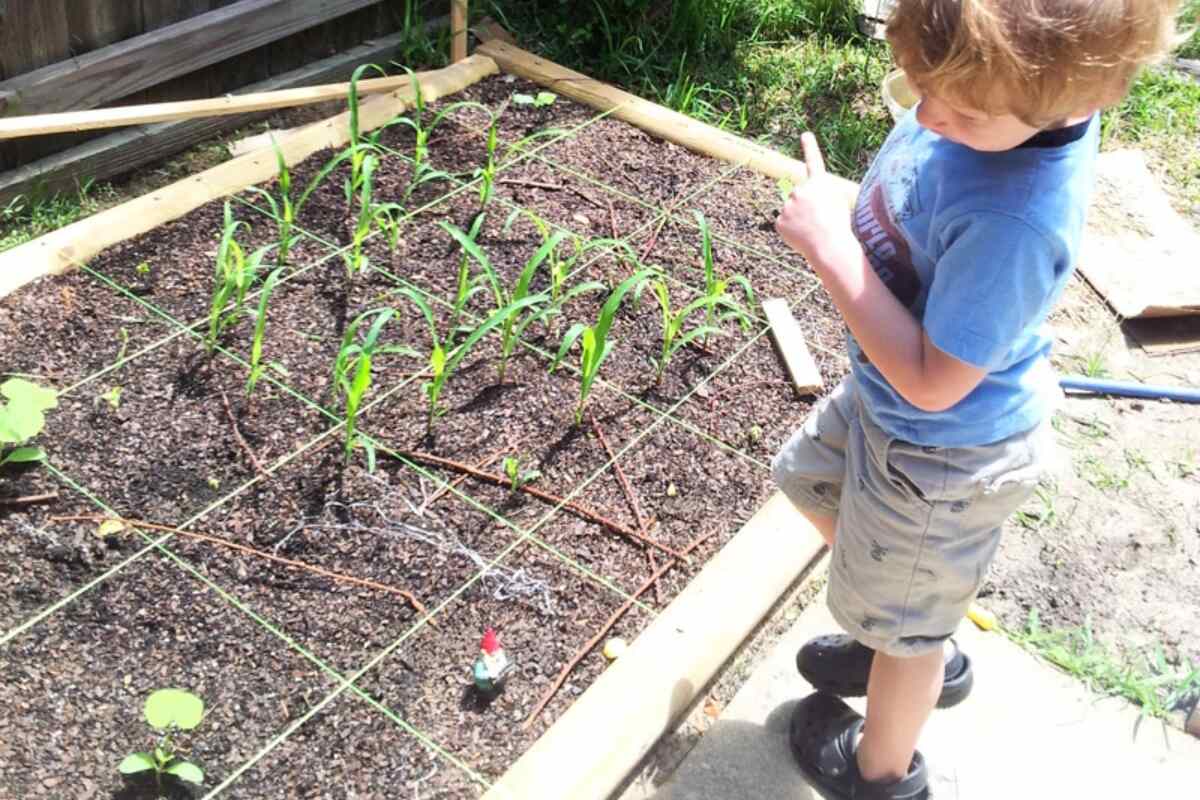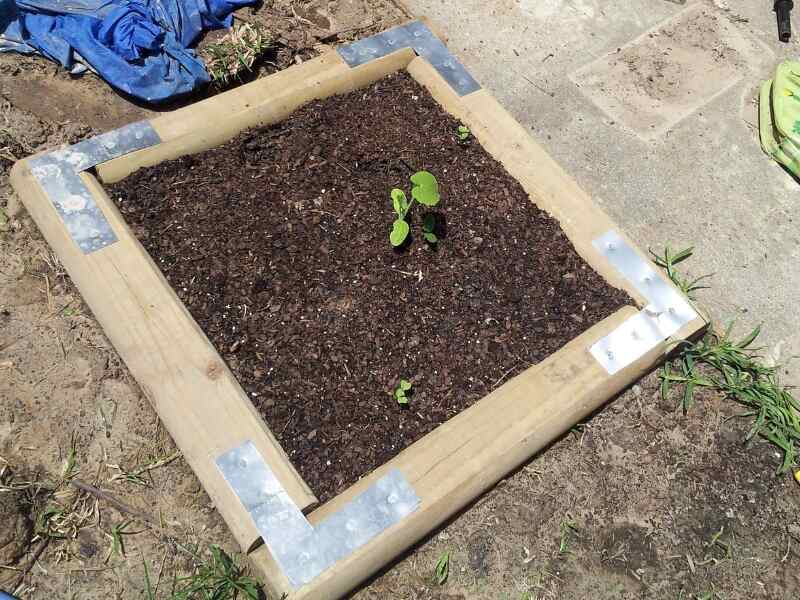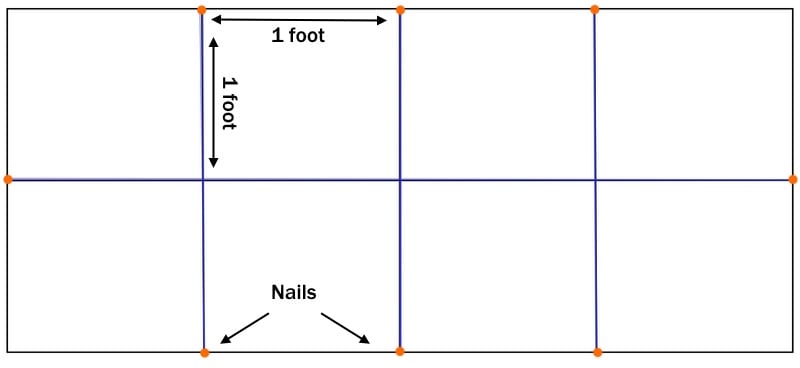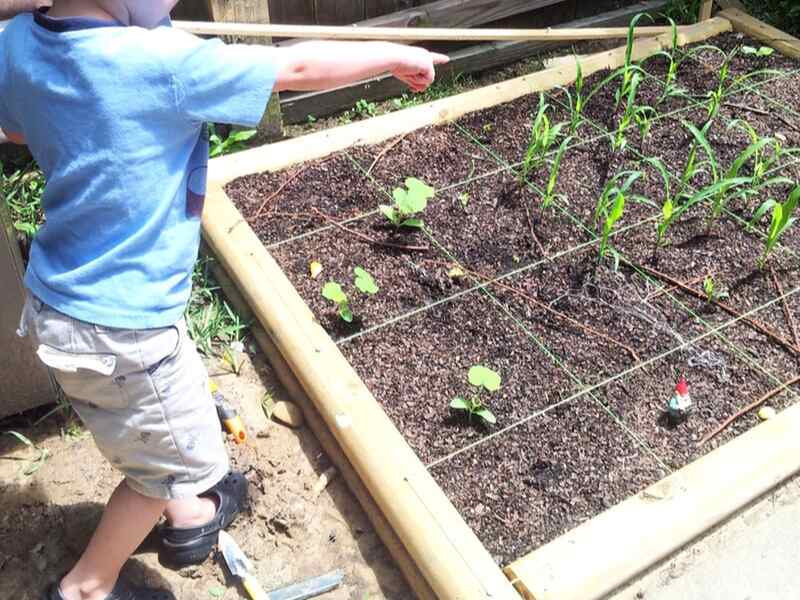
If you want to grow your own food but don’t have a lot of space, consider square foot gardening (SFG). It’s one of the most popular types of backyard gardens because it produces a lot of food but doesn’t require a lot of space or upkeep. We explain everything a beginner needs to know to grow their first square foot garden.
What is Square Foot Gardening?

Mel Bartholomew is the father of the square foot gardening method. He invented it in the 1970s and founded the Square Foot Gardening Foundation in 1996. Today, it’s the most popular backyard vegetable gardening technique. Raised garden beds are filled with a special soil mix and sectioned into 1-square-foot segments.
Square foot gardens take up 20% less space than traditional rows and use about 10% less water. They are low maintenance and excellent for new gardeners.
Why Grow a Square Foot Garden?
There are many advantages to square foot gardening, including:
- Great for small spaces
- Conserves water
- Organic
- Great for beginners
- Fewer weeds
- Facilitates crop rotation
- Low maintenance
- Beds can be raised to an accessible height
- Comes with explicit instructions
- Don’t have to test the soil
For all these reasons, square foot gardens are the best way for new gardeners to dip their toes into growing vegetables, and they’re also the best way to grow your own food in a small urban space.
How to Build a Square Foot Garden
Next, we tell you everything you need to know to build your first square foot garden, including:
- Where to put it
- Square foot garden layout
- How to build a raised garden bed
- How to make the soil mixture
Where to Put It
Square foot gardens are great for small spaces because a small garden produces a lot of food. However, pay close attention to sunlight. The best place to put your garden is in full sun.
Square Foot Garden Layout
Here is the layout of a square foot garden:
- Size: A typical square foot garden is at least 4 by 4 feet, but you can make the bed as long as you want. Most homeowners stick to four feet wide, so reaching each square is easy. You can also make beds as small as one square foot.
- Garden Grid: Each raised bed garden is divided into one-foot squares using lattice strips or twine wrapped around nails.
- Depth: Each bed is 6 to 12 inches deep.
- Plant Spacing: Depending on plant size, 1, 4, 9, or 16 plants typically grow in each square.

How to Build a Raised Garden Bed
You will need the following tools to build a square foot garden, as outlined in Mel’s book, All New Square Foot Gardening:
- Power drill
- Staple gun
- Screws/nails
- Malate (soil amendment)
For the garden box, you’ll need the materials shown in the table below.
| Material | Quantity |
| 2 x 6 Untreated Wood | 4 |
| 4” Wood Screws | 12 |
| 4 Foot Lattice Strips | 6 |
| Machine bolts | 9 |
| Weed barrier | 1 |
And to build the lattice, you’ll need the materials listed in the following table.
| Material | Quantity |
| Rebars | 2 |
| 5 ft. conduit pipes | 2 |
| 4 ft. conduit pipe | 1 |
| Corner joints | 2 |
| Garden trellis string | 1 |
The video below shows step-by-step instructions to build the garden bed. Or, if you learn better by reading instructions, check out our step-by-step guide to building a raised garden bed.
How to Make the Soil Mixture
Mel’s official square foot gardening soil mix contains equal parts of the following:
However, I built my square foot garden in Central Mississippi and strayed from Mel’s Mix by mixing in 50% backyard soil. If you have fertile ground, it’s a shame to waste it.
Square Foot Gardening Basics
Mel focuses on conservation and hearty harvests, so he encourages the following practices:
- Save seeds: Only plant the number of seeds you plan to grow. There are some exceptions to this rule. Carrots and lettuce require 2 – 3 seeds per plant.
- Preserve soil: Rotate your crops each year, meaning you should grow a different variety of vegetables in your garden each season.
- Utilize space: Properly plan your garden based on the food you will consume and plant the appropriate number of plants per square.
- Watering plants: Mel suggests putting water in a bucket to warm in the outside sun. Use a cup to take water from the bucket and apply the water directly to each plant’s root zone. Knowing how often and how much water to give a vegetable garden is essential.
- Organic gardening: Mel encourages organic gardening practices. His method curtails weeds and pests, making it easier for homeowners to grow organic food.
What Crops to Grow

The table below lists popular crops that grow great in a square foot garden, along with the ideal quantity for each crop.
| Crop | Plants Per Square |
| Arugula | 9 |
| Beets | 4 |
| Broccoli | 1 |
| Brussel sprouts | 1 |
| Bush beans | 9 |
| Carrots | 16 |
| Corn | 1 |
| Cucumber | 1 |
| Eggplant | 1 |
| Garlic | 4 |
| Leeks | 4 |
| Onions | 4 |
| Parsnip | 4 |
| Peppers | 1 |
| Pole beans | 8 |
| Radishes | 16 |
| Spinach | 9 |
| Sunflowers | 1 |
| Turnips | 9 |
| Thyme | 4 |
You can also plant melons and squash (such as watermelon and pumpkins) in a square foot garden, but beware that the plants have long vines that need room to sprawl. Place these vining plants in a corner square so they can sprawl outside the box. Grow one plant in one to two squares.
Gardening Tips
Here are some general gardening tips to ensure a hearty, plentiful harvest:
- Don’t remove plants: If you have extra plants, trim them back instead of removing them.
- Add mulch: Mulch your garden to shade the soil. The sun will evaporate less water, so more water gets to your plants, and the shady ground discourages weed growth.
- Consider germination rate: Plant extra seeds when growing plants with a low germination rate. About half the sowed seeds will sprout if they have a 50% germination rate. Anything below 70% is considered low.
- Plant what you eat: Plant crops you and your family enjoy and consider your home cooking practices.
- Preserve extras: Have a plan for preserving extra food, such as bottling jellies, drying beans, and freezing veggies. Also, ask friends and family if they’re willing to take some of the extra fruits of your labor off your hands – few people will turn down free food!
- Consider the crop’s growing season: Select plants appropriate for your hardiness zone and plant crops at the proper time for your climate. Regional soil type doesn’t matter because you’re using Mel’s garden soil mix in a raised bed.
- Companion plant: Companion planting methods help keep your soil healthy and your harvest plentiful.
FAQ About Square Foot Gardening
The downsides of square foot gardening include the following:
● Startup cost: They cost a lot upfront. You have to buy or build a garden bed and purchase soil components.
● Large plants: The method isn’t the best for plants like zucchini and large potatoes that require a lot of space.
● Labor: It takes work to build the raised garden bed.
● Peat Moss: Harvesting peat moss hurts the environment. It leaves a carbon footprint and damages the habitats of birds, insects, reptiles, and small mammals. Consider using coconut coir instead.
You can build a square foot garden with as little as 2 square feet.
Three Sisters Gardening is a Native American companion planting technique. Corn, pole beans, and squash are nutritious and thrive beside each other. I used the Three Sisters combo in my own square foot garden to great success.
Using the square foot method, you don’t need much space to grow a Three Sisters Garden in your backyard:
● Plant 4 corn seeds in one square. Corn should get planted after spring’s last frost, and it prefers 77 to 91-degree daytime temperatures.
● Plant 4 pole bean seeds in each corn square. Do this when the corn is a few inches high, about 2-3 weeks after planting it. Each bean plant goes beside a corn plant.
● Plant 1 squash seed (by itself) in the four corner squares. Do this about one week after the beans sprout. Larger squash varieties may require two squares, but smaller squashes like pie pumpkins are fine with one. Just ensure the vines have room to sprawl out of the box.
You want to grow the Three Sisters in a square foot garden bed that’s at least 8 square feet, but many homeowners use beds as large as 20 square feet.
Garden planning is a key component to successful veggie production. There are a few simple steps to start a vegetable garden, including:
● Managing your expectations
● Finding the perfect garden space
● Examining the soil
● Choosing the right crops
● Choosing the best planting method for your space
Get a Helping Hand
Once a square foot garden gets going, its upkeep is easy and affordable. But it takes proper planning and some heavy lifting to get your garden off the ground. Seasoned home gardeners know they can rely on LawnStarter pros to help with special projects or routine maintenance. Finding an affordable landscaping pro in your area is quick and easy online or in our mobile app.
Main Photo Credit: Michelle Selzer
LawnStarter participates in the Amazon Services LLC Associates Program, an affiliate advertising program. LawnStarter may earn revenue from products promoted in this article.